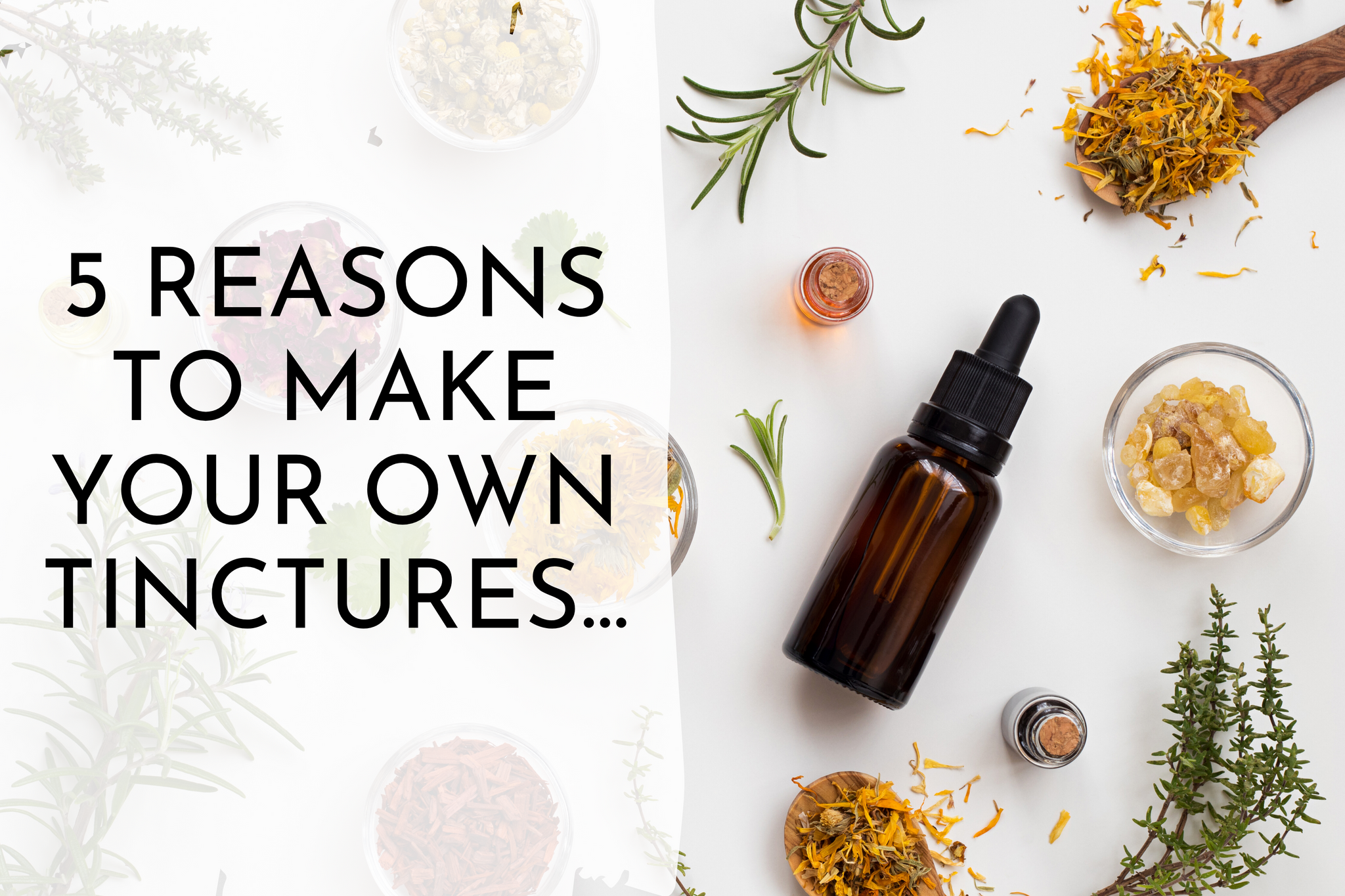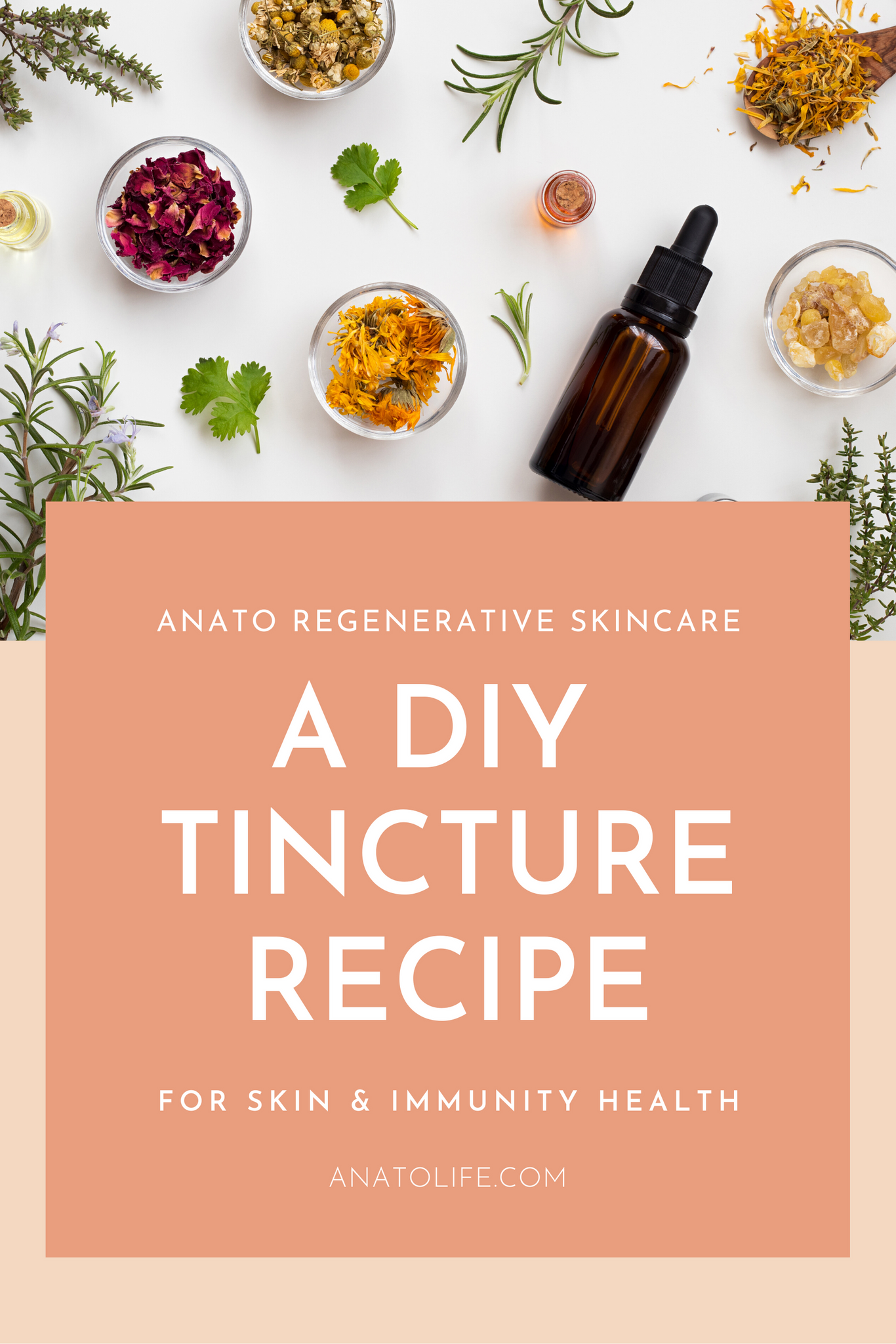
Our founder Céline Jennison, commonly makes tinctures at home to help cure all sorts of every-day ailments.
What Is A Tincture? + Other Key Terminology:
Tincture = A tincture is simply an alcohol based plant extract. Think of it like making a tea, except instead of soaking the plant in water, and drinking the delicious and nutritious tea, you are soaking the plant in alcohol.
Menstruum = refers to the base liquid being used to pull out the constituents of the plant. So for a tincture, alcohol & water are the menstruum. For a tea, water is the menstruum. For something like our Baume Réparateur or our Regenerative Elixir, oil is used as the menstruum to infuse the herbs into.
What are the benefits of tinctures?

※ The alcohol menstruum pulls out the many different health compounds in the plant. All water-soluble compounds are drawn out efficiently by the alcohol base.
※ Alcohol is a preservative, making tinctures shelf stable for a long time. This tincture recipe can last years - though over time may become less potent.
※ Tinctures are very concentrated. This means you generally just need to take a few milliliters a day to get all the benefits (though specific dosage varies plant by plant). This tincture recipe will provide you with plenty of tincture.
※ Multifunctional health benefits! Plants are bestowed with many different compounds, vitamins, and minerals. This multifaceted composition means they serve many different purposes. Echinacea, for example, is great for the immune system, and the skin! Since echinacea helps fight off infection, it could be used internally to fight off a viral infection, or it can be used topically to fight off a staph infection, an infected wound, and even acne. We have a guide full of multifunctional health benefits plants offer us, like how you can eat your sun protection!
※ Healthy skin from the inside out - when we consume tinctures to bring balance to our internal health, our skin will surely reap the rewards and radiate health outwards.
Why a DIY tincture recipe?

⚘ Fresh is best. Who knows how long that tincture has been sitting on a shelf? When you make a tincture at home, you know it is as fresh as possible.
⚘ Make extra and share with friends.
⚘ Fun and creative hobby. For other plant-based, creative hobbies click here.
⚘ Making tinctures is pretty easy! Anyone can learn how to do it.
⚘ You can blend herbs that will specifically serve you. Whether you grow the plant in your home garden, or buy it dried there's an extra little something that happens when you make it yourself.
What is echinacea and what are its benefits?

Echinacea purpurea is a beautiful perennial coneflower with a purple bloom. Native to the Americas, it has been used for hundreds of years for its significant immunomodulating properties (1). Immunomodulating means it helps bring balance and overall support for your immune system.There are other species of echinacea, like echinacea angustifolia, that are also medicinal and definitely worth tincturing. In particular, there has been evidence for acute upper respiratory benefits, and benefits for skin health. Taking echinacea can help reduce the duration and severity of a cold or infection (2).
Echinacea Tincture Recipe - Step by Step Instructions:

What you need:
⟡ 50g of dried* echinacea (roots, flowers, and/or leaves)
⟡ 250 mL of menstruum (anything over 20% alcohol - 80 proof liquor of choice works well here)
⟡ An airtight jar like this one.
⟡ Coffee grinder
⟡ Strainer
⟡ Cheesecloth
⟡ Label paper
Step 1: Place herbs in a clean coffee grinder and pulse a few times. This helps to break down the cell walls
Step 2: Place herbs and menstruum in a jar and stir well. It is ok if the herbs are not fully covered in the menstruum, as long as everything is saturated.
Step 3: Label the jar clearly with the date & the ingredients.
Step 4: Store the jar in a cool place, out of direct sunlight. Shake the jar daily for 2-4 weeks.
Step 5: Strain ~ Grab a clean bowl or large measuring cup. Place a strainer, lined with cheesecloth, over the bowl. Pour the tincture through the cheesecloth. Squeeze all of the liquid out of the wet herbs, and compost the herbs.
Step 6: Bottle ~ Pour the tincture into an amber, or colored glass tincture bottle. Label the tincture clearly with the date and ingredients.
Storage: Keep your tinctures in a cool, dark place, like a medicine cabinet or kitchen cupboard.
Useage: Echincaea can be taken internally by adding dropperfuls to your waters or teas, or directly into your mouth. You can also add this echinacea tincture recipe to your DIY skincare recipes. Add a drop or two to our Kelp Forest Face Mask for an extra acne-fighting boost.
* If you have access to fresh echinacea - by all means use it instead of dried! Make sure your menstruum is closer to 70% alcohol or more, and your ratio of echinacea to menstruum should be closer to 1:2. (1 part g of echinacea by weight : 2 parts volume in mL of menstruum)
SIMPLE ECHINACEA TONER RECIPE FOR YOUR FACE
We recommend repurposing your empty 3-in-1 super sanitizer bottle for this one so that you can use the mist sprayer on your face.
Other holistic wellness DIY projects:
↠ For more information on tincture recipes, along with several more holistic tips for strengthening your immune system, check out our free guide!
↠ This blog post includes a recipe for a forest based room cleanser, and a bath tea!
↠ Eating non toxic foods is important, and so is non-toxic food storage. Check out the DIY Beeswax Food Wraps workshop hosted by Anato's, founder, Céline.
Want more holistic wellness tips?

*This Content is not intended to be a substitute for professional medical advice, diagnosis, or treatment. Always seek the advice of your physician or other qualified health provider with any questions you may have regarding a medical condition.
References:
- Barrett, B. (2003). Medicinal properties of Echinacea: a critical review. Phytomedicine, 10(1), 66-86. Percival, S. S. (2000). Use of Echinacea in medicine. Biochemical pharmacology, 60(2), 155-158.
- Hooper, L. V., Littman, D. R., & Macpherson, A. J. (2012). Interactions between the microbiota and the immune system. science, 336(6086), 1268-1273.

